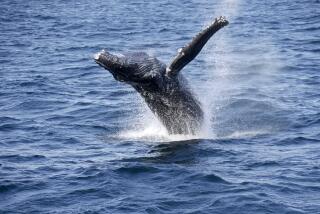âAhabâ Charts Survival for Whales
GULF OF MEXICO â The afternoon was still and sultry, and the big whale lolled in the vacant sea, spouting.
Poised in the bow of his orange dinghy, Mark Johnson held a long pole and took aim as he drifted toward the beastâs broad back.
Sweat dripped into his eyes, stinging. His wet ponytail clung to his back like kelp.
It was a moment lifted from the pages of âMoby Dick.â Like Captain Ahab, Johnsonâs target was a 60-foot sperm whale, the worldâs largest toothed creature.
The whale quivered. Johnson struck.
Rather than thrusting a harpoon deep into its blubbery girth, he tapped the surprised whale with the pole, attaching a digital recorder no larger than a paperback book.
The whale slipped, unharmed, beneath the waterâs glassy veneer.
Johnson slumped, exhausted.
Take that, Ahab.
âOne or two tags a day is as much as I can do,â Johnson explained afterward. âThings happen so fast. The concentration it requires is incredible.â
Johnson, from the Woods Hole Oceanographic Institution on Cape Cod, is among two dozen scientists who started a $1-million survey of sperm whales in the Gulf of Mexico this summer.
Their work is sponsored by several federal agencies and orchestrated by the Minerals Management Service, which regulates offshore industry. The study will run through 2003.
Scientists are surprised that 500 endangered sperm whales, along with killer whales and rare pilot whales, have quit the open ocean to congregate year-round near the mouth of the busy Mississippi River.
Among their questions: Where did they come from, and who are their relatives? Whatâs luring them so close to shore? How do they communicate? And how do underwater noises such as oil drilling and naval sonar affect them?
Answers would dramatically expand our knowledge of the behavior and genetics of the endangered creature. More than curiosity is prompting such a major inquiry, however.
These whales, protected by federal law, have strayed into dangerous waters.
The northern gulf, besides being one of the worldâs busiest shipping channels, is one of its most productive energy zones. There are more than 3,700 offshore oil and gas platforms from Mexico to Mobile.
The whales face potentially deadly hazards ranging from collisions with ships to disorienting underwater noise.
And oil companies want to drill more wells farther out, where the Continental Shelf plunges into petro-rich submarine canyons, an area known as Sale 181. It is a crucial part of the Bush administrationâs policy to boost domestic energy production. New leases could be sold by December.
Conservationists dread industryâs creep into deeper waters.
Here, as in so many other wild locations, the nationâs energy demands are clashing with imperiled wildlife.
âDeep-sea drilling is a collision course between an endangered mammal and the industryâs bread-and-butter activity,â said Richard Charter of Environmental Defense, an advocacy group.
âThe new leasing is going forward with a very minimal environmental study,â he said. âItâs a quest for energy at any cost.â
Industry officials say the relative abundance of sperm whales in the gulf is proof that offshore development isnât harmful. They complain that the White House already has slashed Sale 181âs area by 75% to appease environmental and political concerns in Florida.
Operations are slowed or suspended whenever marine mammals enter an energy area, said Thomas Michels, spokesman for the National Ocean Industries Assn. The same regulations would apply to new wells.
So how are the whales faring?
Nobodyâs sure.
âWe donât know much about their genetics, their social structure, their ranges or their behaviors,â said Keith D. Mullin of the National Marine Fisheries Service.
Despite Moby Dickâs ugly disposition--sinking all those ships and drowning sailors--sperm whales are not manhunters.
âIf you think of the Gulf of Mexico as the Great Plains,â said oceanographer Robert Gisiner of the Pentagonâs Office of Naval Research, âthen sperm whales are like bison.â
Which, it should be noted, were hunted nearly to extinction, like the whale. Perhaps 10% of the sperm whalesâ original population of 2 million survive.
Today, Japan and other nations are beginning to defy the whaling ban. But most whales are more likely to become the unintended victims of commerce.
Sharp propellers sometimes gouge them. Pollution poisons their food chain.
But the real enemy is noise. Underwater, the gulf sounds like a factory floor. Engines hum. Drills grind. Propellers hiss. Hulls vibrate.
The commotion can disrupt the whalesâ ability to navigate and communicate by echolocation, a natural form of sonar.
Sperm whales emit a clicking sound that zips through the water and bounces off an object. If the click returns quickly, the object is near.
With the largest brain in the animal kingdom, the whaleâs head bulges with features that organize sounds, map terrain, avoid obstacles.
Noise pollution silences whales and drives them away. Extreme noise causes hemorrhaging and fatally damages their echolocation equipment.
Eighteen months ago, eight whales died after the Navy deployed a powerful mid-range sonar during a submarine-detection exercise in the Bahamas.
In Maine, lawmakers and environmentalists are trying to block Navy tests of a more powerful low-range sonar system, fearing the damage it could do.
Learning what affects whales is one reason the Navy is a partner in the gulf survey--although the Navyâs permit for the low-range sonar is expected this fall, long before the gulf study is completed.
Energy activities are more difficult to assess. Drilling produces a steady hum at a low frequency that whales may tolerate.
Seismic exploration is riskier. Ships fire an air gun and sensitive instruments record the acoustic signature of the rebounding concussions. Computers translate the data into three-dimensional maps revealing the oil buried beneath thousands of feet of sea and rock.
Conservationists contend that seismic tests can reach 230 decibels. By comparison, a rock concert peaks at 170 decibels.
Scientists caution that such comparisons can be âmisleading.â
âMarine animals have evolved in a completely different acoustic environment than we have, and they use sounds in ways that we do not,â said Cornell University bioacoustics researcher Kurt Fristrup.
Fristrup said it is âunjustifiable to suggest that our experiences at rock concerts have anything to do with a whaleâs experience in the presence of industrial noise.â
So, how to know?
Eyes--and ears--are turning to the digital tags. The tags only remain attached for several hours, but they record the animalâs every dive and roll, taking note of whether a whale flinches at a noise, or ignores it.
The tag eavesdrops on their conversation. âItâs like the black box on an airplane,â Johnson said.
When the tag floats to the surface, itâs retrieved and its 1.6 gigabytes of data is downloaded to computers aboard a distant research vessel, a former Navy submarine chaser equipped with extra-quiet propellers.
So far, this summerâs best observation is an incident in which menacing killer whales surrounded 10 female sperm whales and calves.
In 1997, a similar episode off California ended in a slaughter of the sperm whales that lasted hours.
This time, the tapes were filled with alarm cries that traveled for miles. The killer whales retreated as a sperm whale cavalry rode to the rescue.
âThey were swimming so hard that the whole fronts of their bodies were lunging out of the water,â Mullin said. âBy the time it was over, there were 25 whales. It just blew my mind.â
Most of the time, though, the tags record industrial background noise while the whales forage. Scientists worry the noise will change their feeding and breeding habits.
Johnson compared it to living near a busy airport. âYou can carry on a conversation,â he said. âBut that doesnât necessarily equate with easy living.â
For his part, Johnson has learned to work quietly around the whales. That doesnât come naturally. Much like a Melville character, Johnson was a landlubber in his native New Zealand--an electrical engineer with a PhD--when he joined Woods Hole in 1994 in search of adventure.
Since then, heâs bobbed in tropical waters and dodged icebergs and 40-foot waves off Greenland. Heâs been soaked by the warning slap of an irritated whaleâs tail.
He marvels at the whalesâ girth-defying grace, their âincredible appropriatenessâ in their watery realm.
âI feel the smallness of the boat,â he said. âI feel clumsy.â
Whalers in the 19th century had no patience for such pondering. Theirs was a gory business.
Once a sperm whale had exhausted itself, harpooners would row alongside and repeatedly stab it until, as Melville wrote, âthe red tide poured from all sides of the monster like brooks down a hill.â
Johnson admits to copying the early whalersâ stealthy approach from behind the creatureâs dorsal fin. He memorized their calculations of whale lung volumes to predict when the animals would surface or dive.
But this is modern science, not some gothic quest for immortality or riches. The tagger feels no bond with the ghosts of sea hunters of yore.
Hint: Stop giving him âMoby Dickâ as a gift.
âIâve already got three copies in my office,â Johnson complained. âNever read it.â
Take that, Ahab.






